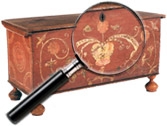|
|
Cartouche – Definition
The decorative arts world has many “squishy” and vague vocabulary words, but few are “squishier” and vaguer than cartouche. Originally, the term comes from Egyptology and is used to describe a oval enclosing hieroglyphics and having a horizontal line at one end. (The line denotes royalty.) The oval had significance not unlike that of a closed circle, in that it was believed that an oval around a person’s name provided protection [...] Click here to continue reading.
Captain Hall J. Tibbits (American, 1797 to 1872)
This article about the life and career of Captain Tibbits by Eric C. Rodenberg appeared on the 4 November 2013 front page of Antique Week’s National Section. Used by permission. http://www.antiqueweek.com.
1800s Sea Captain’s Life Told Through Collection
At 6 foot, 4 inches tall and “powerfully built” Capt. Hall Jackson Tibbits would brook no foolishness.
After his “religious principles” were violated by passengers dancing on [...] Click here to continue reading.
Hoosier and the Hoosier Group
The word “Hoosier” is one of those words whose origins are lost to time. Even The Oxford English Dictionary offers no real guidance about where the word came from. What we do know is that “Hoosier” was first documented in the mid-1820s, and within a decade, it had entered general usage. John Finley, a Hoosier himself from Richmond, write a poem titled, “The Hoosier’s Nest” that was published in [...] Click here to continue reading.
Vermeil
“Vermeil” is a French word co-opted by the English in the 19th century for a silver gilt process. Vermeil is a combination of silver and gold, although other precious metals are also occasionally added, that is then gilded onto a sterling silver object. The reddish (vermilion) hue of the addition of the gold gives the product its name. Vermeil is commonly found in jewelry, and a standard of quality (10 karat gold) and [...] Click here to continue reading.
Baleen, Plastic of the 18th Century
Baleen comes from a suborder of whales, Mysticeti, which includes, among others, humpback whales, gray whales, right whales and blue whales. What sets these whales apart is baleen. These whales do not have teeth, but have upper jaws filled with two rows of baleen plates fringed with fine baleen hair. These plates are so closely aligned that they act like a comb or a sieve; whales pull water [...] Click here to continue reading.
WWI Poster, Irishmen Avenge the Lusitania, p4A item A032936 RMS Lusitania First class dining saloon of the RMS Lusitania RMS Lusitania
The ocean liner Lusitania was launched in 1907 by the Cunard company as part of their drive to dominate the North Atlantic passenger trade between England and New York.
The Lusitania, and her sister ship, the RMS Mauretania, were the largest ships ever constructed at the time of their launch, having fifty [...] Click here to continue reading.
The Battleship Maine
Construction of the U.S.S. Maine was authorized in August of 1886, and she was launched in 1889 and commissioned in 1895. After several years spent patrolling the East Coast and Caribbean, orders sent the Maine and her crew to Cuba in response to continued civil unrest on the island.
The photograph above is a 1896 image of the ship framed in a sheet iron frame made from remnants of [...] Click here to continue reading.
The Collection of Mr. and Mrs. James Grievo, Stockon, New Jersey
It all started around 1971. Just home from college and having a difficult time finding a job, I started going to house tag sales where I would find small interesting things to sell to antique dealers. It was something I really enjoyed doing, and 1 was amazed I was making real money for the first time. I soon realized that this was [...] Click here to continue reading.
A History of Jenny Lind
by J. Revell Carr, Director Emeritus, Mystic Seaport Museum, Mystic, Connecticut (courtesy Sotheby’s.)
Very rarely, a 19th century figurehead emerges from obscurity and is recognized as the work of art it truly is. It is even more rare that such a figurehead is identified and reconnected to the history of the ship it once symbolized. In the Jenny Lind figurehead, we have such a rare find and the story [...] Click here to continue reading.
Woolies
A woolwork picture of a ship – usually a sailing ship – is affectionately called a woolie. If it depicts anything else – a house, dog, flower – it is a woolwork picture. Woolies were the creation of British sailors who got caught up in the embroidery fad that infatuated their wives and daughters in the mid-to late-Victorian era.
The woolwork fad (also called Berlin work for the city where it began) [...] Click here to continue reading.
|
Recent Articles
- Charles Alfred Meurer – American Artist & Tromp L’Oeil Artist
- Sendak, Maurice – American Artist & Writer
- Godie, Lee – American Artist
- Davis, Vestie – American Artist
- Bartlett, Morton – American Artist
- Mackintosh, Dwight – American Artist
- Evans, Minnie Jones – African-American Artist
- Mumma, Ed (Mr. Eddy) – American Artist
- Nice, Don – American Artist
- Savitsky, John (Jack) – American Artist
- Gordon, Harold Theodore (Ted) – American Artist
- Dial, Thornton – African-American Artist
- Doyle Sam – American Artist
- Johnson, Lester Frederick – American Artist
- Finster, Howard – American Artist
|
|
